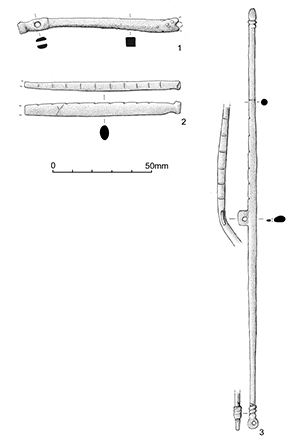
Most of the objects within this category are to do with weighing, and comprise a small number of steelyard and balance fragments, and a very large number of weights (Table 69). Most of the weights are made from lead, and this is one of the largest assemblages of lead weights in the country. The majority came from machining contexts, and it is doubtful whether they are all Roman - indeed six of them were clearly modern fishing weights, one with a piece of the nylon line attached (Type B9). Although there is a river close to the site, the fishing weights were actually found in the middle of the field, and not in close proximity to the river bank. This suggests the possibility that other weights in the assemblage were also post-Roman fishing line or net weights. Various forms of medieval lead fishing weights are illustrated by Steane and Foreman (1988), some of which have parallels in the Elms Farm assemblage. In particular, the most common type from the site (type C4; cylindrical weights made from rolled sheet) occurs in medieval and later contexts (Steane and Foreman 1988, fig. 15), although the dated examples from Elms Farm demonstrate that it can also be Roman in date. It is, however, impossible to distinguish the Roman weights from any later ones that may have been present in machining contexts. Assuming that the primary use of this type of weight is as a line or net weight, the large number of examples may represent elusive evidence for fishing and netting in the vicinity during the Roman period. The nets may have been used for wild-fowling rather than fishing, and indeed a number of different species of wild-fowl are represented in the bone assemblage from Elms Farm, including teal, grey plover and curlew. In the post-Roman period, as the site became increasingly wet and prone to flooding in the winter, wild-fowling using nets may actually have taken place within the excavated area. A post-Roman activity such as this may help to explain why there was such a high proportion of lead weights in the topsoil as opposed to stratified contexts. During the excavation of the site, parts remained flooded throughout the winter, and became temporary homes for various wild-fowl species, including swans.
The five stratified balances and steelyards all came from Areas K and M (both Southern Zone), suggesting a particular association of this zone with activities involving weighing. However, this was not reflected in the distribution of the lead weights, which were found in all zones. The largest number of stratified lead weights came from the Hinterland Zone (seven weights), with six each from the Southern and Northern Zones. Only five steelyard weights (types B2 and B4) came from stratified contexts, and only one of these was from the Southern Zone, so the apparent association of this zone with activities involving weighing may be spurious.

1. Half of a small balance with a pierced vase-shaped terminal. It is broken across a second hole. The surface is pitted, and there are no obvious markings. Square-sectioned bar. L. 80mm. SF9535, 3999, Spoil-heap
2. Balance or steelyard arm with a terminal knob. Variable oval section. The top has ten notches at intervals, and there is an X on the side. There is possibly a shallow notch on the bottom, corresponding with the third one from the knob end. Margaret Brooks notes that one patch of white, waxy corrosion at the broken end is possibly a lead corrosion product. In fair condition. L. 78mm, max. section 7x5mm. SF812, machining layer 4000, Area A, unstratified
3. Balance scale with beam arms of equal length and a central pierced lug, (detached but present). In fair condition but bent sideways in the middle. There are decorative terminals at both arm ends, the left one pierced opposite the right arm (or broken side) which has a series of six graduated notches 7mm to 8.5mm apart along the top to allow the use of a rider-counter piece to balance the suspension pan. L. 188mm. SF407, Fill 4142, Pit 4141, Group 1147, Area K, not dated
4. Not illustrated. Square-sectioned rod with the end looped round itself, in two pieces, both ends broken. This is probably a suspension loop from a steelyard, with a keyhole-shaped loop. The section is unusually flat for a such an object, but is more rounded at the breaks. It is too insubstantial to have been used with heavy weights. Cf. a set of steelyard fittings from Segontium, utilising both square- and circular-sectioned rods for the loops and hooks (Allason-Jones 1993, 172, no. 82). SF1176, Cleaning layer 4325, Area K, not dated
5. Not illustrated. Fragment from one end of a steelyard, with the complete suspension loop. The shorter portion of the bar survives, broken across the loop, and is slightly thicker than the longer portion. There is a fragment of iron in the suspension loop, presumably the remains of a hook or chain. It is similar in size and form to a steelyard from Colchester (Crummy 1988, 99, no. 2508). Surviving L. 35mm, lug diam. 13mm. SF4955, Fill 15043, Pit 15042, Group 650, Area M, Period 6
6. Not illustrated. Circular-sectioned rod, possibly a steelyard arm. One end is broken and slightly bent, while the other has a slight constriction, with a small, damaged knob at the end. L. 84mm, diam. 4mm. SF6660, Fill 15632, Ditch 24445, Group 146, Area M, Period 2B-6
7. Not illustrated. Hook, made from strip of variable width, with a perforated terminal. Probably a large steelyard hook. In two pieces, fresh break, poor condition, surface bubbled. L. 68mm, max. sect. 15x2mm, depth of hook 38mm. SF4666, Machining layer 11000
Not illustrated. Square-sectioned bar, with a solid conical terminal. The other end was broken in antiquity, at a bend. This is probably a fragment of a steelyard, bent and then broken. L. 82mm, bar W. 5mm. Terminal diam. 15mm, L. 14mm. Fill 4994, Pit 4989, Group 1147, not phased
Cite this as: Tyrrell, R. 2015, Lead weights, in M. Atkinson and S.J. Preston Heybridge: A Late Iron Age and Roman Settlement, Excavations at Elms Farm 1993-5, Internet Archaeology 40. http://dx.doi.org/10.11141/ia.40.1.tyrrell8
The lead assemblage includes 355 weights, weighing in total 17.003kg. Two are exceptionally large (1.405kg and 0.895kg) but the rest of the weights are fairly small. 92% weigh less than 100g and 78% of those weigh under 50g (Table 102). This suggests that whatever they were used to weigh, small quantities were involved. If they were for weighing valuable items one might expect the weights to be better finished and appear more precisely made. All the weights have very rough surfaces, and must have been cast in very coarse moulds. This might suggest that the objects were unfinished, but most of the suspension-looped weights had damaged loops. The presence of large quantities of possible casting waste suggests that the weights could have been made on the site, or were being collected for recycling. They may have been a product made for sale, although the presence of some with damaged loops suggests that they were also being used on the site. Large numbers of weights are usually taken to be evidence of trading, and it is possible that a combination of use and sale was taking place on the site.
There are a number of problems associated with relating the ancient and modern weights of these objects. There are discrepancies between estimations of ancient weights that make it difficult to know which version of the Romano-Celtic weights to assign these examples to. A discussion of this problem appears in Evans's work on the lead weights from the Mill Street sites in Caerleon (Evans 2000b, 416-19). The Elms Farm weights were weighed before conservation and so include corrosion products, as well as changes and damage resulting from burial. This must be allowed for when any consideration of their relevance to ancient weights is made. Only 15% of the Elms Farm weights conform to any of the various versions of Roman and Celtic weights quoted by Evans (2000b, 416). It is possible that weights were not viewed with the same expectation of accuracy that modern customers demand, although it may reflect the fact that not all of the Elms Farm weights were used for weighing objects.
| Weight range | Quantity |
|---|---|
| 1-9 | 40 |
| 10-19 | 80 |
| 20-29 | 76 |
| 30-39 | 46 |
| 40-49 | 31 |
| 50-59 | 16 |
| 60-69 | 17 |
| 70-79 | 5 |
| 80-89 | 5 |
| 90-99 | 5 |
| 100-109 | 15 |
| 200-209 | 5 |
| 300-309 | 4 |
| 500+ | 2 |
An exceptionally wide variety of shapes was identified, a total of twenty-nine. Some of the weights classified here would have been used to weigh things down (e.g. fishing weights, plumb-bobs and spindlewhorls) rather than for measuring weight They are included here and will be cross-referenced in the relevant places. The type series includes all the weights found on the site, whatever their date. A large proportion of the weights came from machining contexts, and twenty-one of the types had no examples from stratified contexts. They cannot necessarily be assumed to be Roman; type B9, for example, is clearly a modern fishing weight
The weights were classified into three main types according to the method of suspension. Type A comprises perforated weights, Type B includes those with suspension loops, and Type C those with no means of suspension. These types were further subdivided according to shape. The quantities from each type are given in Table 103. All the weights are cast unless otherwise stated.
| Type | Quantity | Type | Quantity | Type | Quantity |
|---|---|---|---|---|---|
| A1 | 26 | B1 | 1 | C1 | 5 |
| A2 | 21 | B2 | 6 | C2 | 1 |
| A3 | 9 | B3 | 2 | C3 | 10 |
| A4 | 6 | B4 | 23 | C4 | 190 |
| A5 | 6 | B5 | 2 | C5 | 5 |
| A6 | 2 | B6 | 1 | C6 | 11 |
| A7 | 2 | B7 | 1 | C7 | 3 |
| B8 | 1 | C8 | 3 | ||
| B9 | 6 | C9 | 2 | ||
| C10 | 4 | ||||
| C11 | 2 | ||||
| C12 | 2 | ||||
| C13 | 2 | ||||
| Total | 72 | 43 | 240 |
Type A (Figures 524 and 529) - These weights are perforated through the main body of the object and are subdivided into seven different shapes. The two commonest of these are A1 and A2.
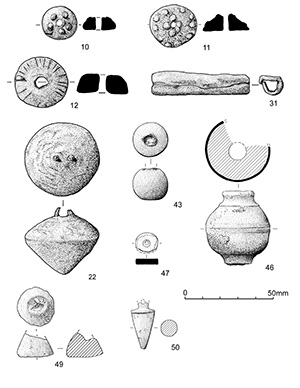
| Type | Quantity | No. from machining contexts | No. from dated contexts |
|---|---|---|---|
| A1 | 26 | 23 | 3 |
| A2 | 21 | 21 | 0 |
| A3 | 9 | 9 | 0 |
| A4 | 6 | 5 | 1 |
| A5 | 6 | 5 | 1 |
| A6 | 2 | 2 | 0 |
| A7 | 2 | 2 | 0 |
| Total | 72 | 67 | 5 |
A1. Disc-shaped. The size of these varies between 16mm and 36mm in diameter, and from 3mm to 10mm thick (those thicker than 10mm, see Type A5). They are perforated centrally with a hole less than 5mm in diameter. This is considered to be the minimum practical hole diameter for a spindlewhorl (Crummy 1983, 67). These objects can resemble washers but are more carefully made. Weight range: 6g to 64g.
This was the commonest of the forms in Type A. Three A1 weights came from dated contexts. One was from a Period 3B pit [9015] with mid-1st to mid-2nd-century AD pottery, a second was from a Period 3 layer (3765), and the third from a Period 5-6 ditch. A lead spindlewhorl of similar shape was found in an early 1st to late 2nd-century AD context during excavations at Castleford (Mould 1998, 121-3), and although described as a spindlewhorl, the small size of the hole suggests that it may be an A1 type weight, underlining the use of this type in the Early Roman period.
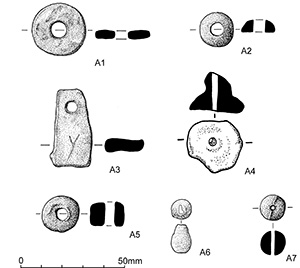
8. (Figure 524.A1) Type A1 weight, with a slightly crookedly made hole. Wt 20g. SF6883, Machining layer 17000, Area Q
A2. Domed. These have flat circular bases, between 12mm and 35mm in diameter, and are 4mm to 33mm tall. The weight range is 6g to 68g, with the exception of one with an unusually large hole (diam. 22mm), which weighs 170g. Two of these weights have been decorated with raised dots around the top of the domed surface and another has lines radiating from the hole. It is unlikely that these are spindlewhorls as they are somewhat small, with small holes (3-5mm diam.), which would only allow the use of a rather thin and consequently flimsy spindle. None is from dated contexts.
9. (Figure 524.A2) Type A2 weight, slightly concave underside. Wt 10g. SF8204, Context 3999, Spoil-heap
10. (Figure 529.10) Type A2 weight, decorated with five small blobs of lead added to the freshly cast weight Wt 14g. SF814, Machining layer 4000
11. (Figure 529.11) Type A2 weight, decorated as above but with four dots around the hole and ten around the edge. Wt 21g. SF5170, Machining layer 11000
12. (Figure 529.12) Type A2 weight, cast with vertical lines around the sloping sides. Wt 45g. SF4283, Machining layer 11000
A3. Oblong. Narrow rectangles of metal tapering at the perforated end, with rounded corners. Dimensions vary between 12mm and 47mm long, though thickness only varies from 6mm to 9mm. Weight range: 16g to 34g.
13. (Figure 524.A3) Type A3 weight, slightly misshapen as if removed from the mould before setting was complete. The 'Y' shaped mark is probably an accidental scratch. Wt 28g. SF4053, Machining layer 12000, Area R
A4. Conical. These weights are perforated from the top of cone to the centre of the base, often crookedly. Dimensions vary from 18mm to 25mm in diameter, and from 9mm to 26mm in height Weight range: 10g to 35g. A weight of this type was found in a Period 5-6 ditch [10406] in Area F, so it is possible that this is a later Roman type.
14. (Figure 524.A4) Type A4 weight, roughly made with curved sides and a non-symmetrical hole. Wt 35g. SF5170, Machining layer 11000
A5. Drum-shaped. These are squat cylinders, with slightly rounded edges, and a central perforation. Dimensions vary from 16mm to 25mm in diameter and from 17mm to 35mm in height Weight range: 10g to 28g. A pit fill, 23124, in Area N, with mid-1st century AD pottery, produced a weight of this type.
15. (Figure 524.A5) Type A5 weight, a well-finished example. Wt 24g. SF7851, Fill 23056, Pit 23124, Group 236, Area N, Period 2B
A6. Pear-shaped. These drop-shaped blobs of metal are pierced through where the 'core' of the 'pear' would be. It is possible that these are badly made Type A4 weights. Weights: 34g and 98g.
16. (Figure 524.A6) Type A6 weight, damaged at the narrow end. Wt 34g. SF5286, Machining layer 11000
A7. Spherical. The spheres have central perforations. Weights: 10g and 12g.
17. (Figure 524.A7) Type A7 weight, unusually well finished, and bead like. The rough seam between the two halves of the mould has not been cleaned off. The condition and finish of this weight suggests that it is post-medieval. Wt 12g. SF7063, Machining layer 17000, Area Q
Type B. (Figures 525, 526 and 529) These weights have iron suspension loops, possibly for use with a steelyard. 62% of this type are biconical (B4), a pattern echoed in the rest of the county (H. Major, pers. comm.).
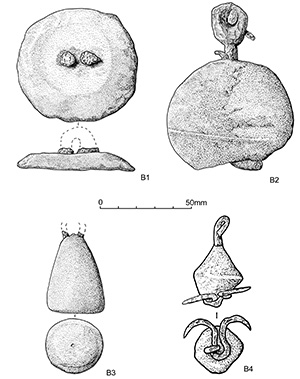
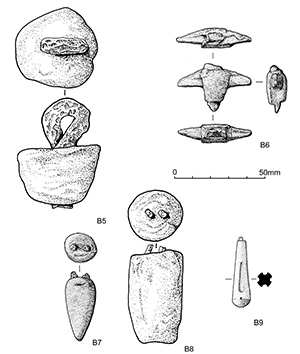
| Type | Quantity | No. from machining contexts | No. from dated contexts |
|---|---|---|---|
| B1 | 1 | 1 | 0 |
| B2 | 6 | 3 | 1 |
| B3 | 2 | 2 | 0 |
| B4 | 23 | 21 | 1 |
| B5 | 2 | 2 | 0 |
| B6 | 1 | 1 | 0 |
| B7 | 1 | 1 | 0 |
| B8 | 1 | 1 | 0 |
| B9 | 6 | 6 | 0 |
| Total | 43 | 38 | 2 |
B1. Disc-shaped. A slightly convex disc with traces of the loop springing from the center of the disc.
18. Type B1 weight, very roughly cast, and with an iron loop (Figure 525.B1). Wt 192g. SF278, Machining layer 4001, Area A
B2. Spherical. The sizes of all but two of these weights vary from 26mm to 40mm in diameter and between 52g and 92g in weight The other two weights are considerably heavier, one weighing 895g, and the second, which is damaged, at least 1405g. The smaller of these came from the silting up of a Period 3-4 well 6280 in Area H, and is the only example from a dated context.
19. Type B2 weight, with the loop intact but damaged (Figure 525.B2). Wt 1405g. SF2368, Cleaning layer 6000, Area H
B3. Conical. These weights have the loop at the tip of the cone. There were two of this type, one weighing 32g and the other 218g.
20. Type B3 weight, unusually well finished (Figure 525.B3). Wt 218g. SF6354, Machining layer, Area R
B4. Biconical. The size range of these weights is from 19mm to 45mm in diameter and from 35g to 338g in weight This was the commonest of the shapes in category B. One example was found with mid-3rd century pottery in a pit in Area K [14125]. The B4 weight from Crescent Road, Heybridge (Wickenden 1986, 26-7, fig. 12) is slightly later, from a mid/late 3rd to 4th-century pit.
21. Type B4 weight, roughly cast, but with a length of iron wire, curled over at the top to form the loop (Figure 525.B4). This passes through the weight forming a loop at the base. A double hook has been passed through this, perhaps in order to hang extra, smaller weights. Wt 63g. SF3246, Cleaning layer 9304, Area D
22. (Figure 529.22) Type B4 weight, roughly cast and with traces of the iron loop at the top only. Wt 250g. SF5282, Machining layer 11000
B5. Domed. The loop springs from the centre of the flat surface so the weight hangs domed side down. These objects weighed 130g and 328g.
23. Type B5 weight, roughly cast and with a large iron loop springing from the flat side (Figure 526.B5). Wt 328g. SF3745, Machining layer 11000
B6. Winged. A complex-shaped weight, for which no close parallel has yet been found. However there is a slight similarity in shape with a copper-alloy weight found in the bedding of a mosaic in a building in Dorchester, Dorset (Draper and Chaplin 1982, 109 no. 2). The 'wings' are round-sectioned and curved downwards.
24. Type B6 weight, tapered rectangular block with three triangular arms (Figure 526.B6). The scar of the damaged loop can be traced on the fourth side of the rectangle. This complex shape appears to have been cast in one piece. Wt 26g. SF5168, Machining layer 11000
B7. Conical. The loop springs from the base of the cone rather than the tip. There is a single example of this type from a poorly stratified context. A larger weight of this shape was found in a 1st to mid-2nd century context in Colchester (Crummy 1983, 101).
25. Type B7 weight, with traces of the iron loop (Figure 526.B7). Wt 52g. SF6413, Machining layer 12257, Area R
B8. Cylindrical. This weight tapers slightly towards the base. The single example weighs 246g.
26. Type B8 weight, very roughly cast, with traces of the iron loop (Figure 526.B8). Wt 246g. SF1022, Machining layer 4000
B9. Teardrop shaped. The suspension loop comes from the point of the weight, which has a rounded base. These are well made, and in good condition. The nylon line attached to one example confirms that they are modern fishing weights. All six examples are from machining layer 11000.
27. Type B9 weight (Figure 526.B9). Wt 77g. SF7199, Machining layer 11000
Type C. (Figures 527 and 528) These weights have no detectable method of suspension, and if used for weighing may have been used with pan balances. Some of this type may have been used as counters, particularly the disc-shaped Type C1. Apart from C4, of which there were an exceptional number; Types C3 and C5 were the most numerous.
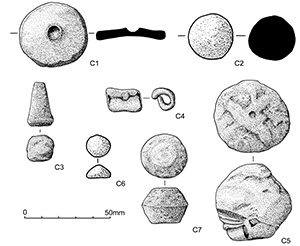
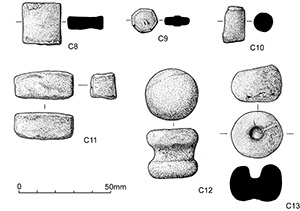
| Type | Quantity | No. from machining contexts | No. from dated contexts |
|---|---|---|---|
| C1 | 5 | 4 | 1 |
| C2 | 1 | 1 | 0 |
| C3 | 10 | 10 | 0 |
| C4 | 190 | 180 | 7 |
| C5 | 5 | 5 | 0 |
| C6 | 11 | 11 | 0 |
| C7 | 3 | 2 | 1 |
| C8 | 3 | 2 | 0 |
| C9 | 2 | 2 | 0 |
| C10 | 4 | 4 | 0 |
| C11 | 2 | 2 | 0 |
| C12 | 2 | 2 | 0 |
| C13 | 2 | 2 | 0 |
| Total | 240 | 227 | 9 |
C1. Disc-shaped. The thinner form of this type could be equally be described as a counter or a weight, but are included here. Apart from one particularly thin example (2mm thick), they vary from 5mm to 10mm in thickness and 22mm to 43mm in diameter. This type ranges from 16g to 50g in weight, with the exception of the thin one, which weighed 6g. Only one C1 weight was found in a dated context. This example (SF1818) came from Period 3 occupation debris with much residual material (6053). A weight similar to these was found in an early 1st to late 2nd-century context during excavations at Castleford (Mould 1998, 121-3).
28. Type C1 weight, very roughly cast (Figure 527.C1). Wt 54g. SF5564, Machining layer 11000
C2. Spherical. A single example measuring 26mm in diameter, was found in the topsoil.
29. Type C2 weight, very roughly cast, with one flat face, presumably to stop it rolling (Figure 527.C2). Wt 86g. SF1021, Machining layer 4000
C3. Conical. These are roughly cast, somewhat rounded cones. Three weigh 4g, one weighs 6g and the rest of the ten weigh between 20g and 172g.
30. Type C3 weight, roughly cast tall narrow cone (Figure 527.C3). Wt 20g. SF5662, Machining layer 11000
C4. Rolled. Unlike the other types of weights, these were not made by directly casting a simple block but by rolling a pre-cast sheet rectangle into a narrow, occasionally uneven, cylinder. The range of sizes varies widely from 7mm to 60mm in diameter and from 12mm to 72mm long. The weight range is also great, between 2g and 114g. There are 190 of this type making it the commonest form of weight overall, comprising 53% of the assemblage. It has been suggested that these objects may be fishing line or net sinkers or possibly functioned as sack closure/seals. Many of these objects are unstratified and were found using a metal detector during topsoil stripping, but there were examples from stratified contexts. Three C4 weights came from a 2nd-century fill in a well, 12245, in Area R. Although the well itself passed out of use in the 2nd century, Late Roman and Saxon pot in its top show that more material accumulated later. The weights may come from the final, Late Roman, infilling. Other examples came from a Period 4 pit in Area K, 4913, a Period 5-6 ditch in Area F 10406, a Period 4 pit in Area M, 24197 and a Period 4 pit in Area M, 15354. A similar object from a Roman site at Mill Street, Caerleon (Evans 2000b, 415-16) is described as a tube, function unknown. The Caerleon Fortress Baths (Zienkiewicz 1986, 191, fig. 65, 11), excavations at Neath (Evans 1992, 255, no. 1) and at Loughor (Evans 1997, 294, nos 19 and 20) produced further examples. Three more examples from Crescent Road, Heybridge (Wickenden 1986, 26-7, fig. 12) are from mid/late 3rd-4th-century contexts.
| Area | A1 | A2 | Q | B | R | K | A3 | M | X | C | E | F | I | N | W |
|---|---|---|---|---|---|---|---|---|---|---|---|---|---|---|---|
| Quantity | 60 | 50 | 38 | 14 | 10 | 5 | 3 | 2 | 2 | 1 | 1 | 1 | 1 | 1 | 1 |
Areas A1, A2, A3, B, C and X, in Table 107, are non area-specific unstratified contexts. All of those from Q and all but three from R were collected from the topsoil during machining.
31. Type C4 weight, one of the longest examples, with the edges rolled together and not soldered (Figure 529.31). Wt 52g. SF5171, Machining layer 11000
32. Type C4 weight, a loosely rolled example, shorter than average (35mm) (Figure 527.C4). Wt 14g. SF5171, Machining layer 11000
C5. Biconical. The diameters of these weights are larger than their tip to tip length, resulting in a somewhat squat appearance. No traces of suspension loops could be found and only one of the five weights of this type rested on a flattened base. The rest sat at an angle. The weights range in size between 62g and 366g.
33. Type C5 weight, with several small holes, which may be casting faults and deep grooves, one being recent damage (Figure 527.C5). Wt 366g. SF6585, Machining layer 17000, Area Q
C6. Domed. There are eleven examples of this type of weight, ranging from 4g to 54g in weight, apart from one weighing 404g. With the exception of the C4 weights this was the commonest of the shapes in category C.
34. Type C6 weight, somewhat roughly cast (Figure 527.C6). Wt 14g. SF6588, Machining layer 17000, Area Q
C7. Truncated Biconical. These are similar to the C5 weights but without points and weigh 24g, 28g and 70g. One of these (SF5436) came from the floor of Building 39 which has been dated to the mid- to late 2nd century. A larger, but similarly shaped, weight was found in Castleford (Mould 1998, 122) in an early 1st to late 2nd-century context.
35. Type C7 weight (Figure 527.C7). Wt 70g. SF5285, Machining layer 11000
C8. Rectangular. These are fairly evenly made and probably cast rather than clipped from sheet. There is little variation in thickness, between 7mm and 8mm. The three examples of this type weigh 12g, 24g and 42g. These are similar to Types 3 and 4 of a series of weights from the off-site spoil from the Vintry site in the City of London (Drinkall and Stevenson 1996). This is an assemblage of 115 unsuspended weights of Roman and medieval date.
36. Type C8 weight, almost square, and slightly thicker at the edges (Figure 528.C8). Wt 24g. SF5319, Machining layer 11000
C9. Polygonal. The two weights of this type may have been cut from sheet or moulded and weigh 6g and 76g.
37. Type C9 weight, with a small raised rough patch in the centre of each face (Figure 528.C9). Wt 6g. SF5354, Machining layer 11000
C10. Cylindrical. These differ from Type C4 in that they are cast as solid forms. These four examples weighed 18g (2 of these) 20g and 36g.
38. Type C10 weight, with a slight hollow at each end (Figure 528.C10). Wt 20g. SF5414, Machining layer 11000
C11. Brick-shaped. These have square ends and rectangular sides, similar in shape to a modern brick. The two examples weighed 28g and 56g.
39. Type C11 weight, roughly shaped and finished (Figure 528.C11). Wt 56g. SF5497, Machining layer 17000, Area Q
C12. Reel-shaped. This is similar to the bun-shaped type C13, but with a shallow groove round the middle and a flattish top and bottom. These weights could have had a cord tied around the waist for use as a hanging weight, or a plumb bob. No wear patterns were visible after conservation to assist identification. These objects weighed 24g and 128g.
40. Type C12 weight (Figure 528.C12). Wt 128g. SF7164, Machining layer 17150, Area A
C13. Bun-shaped. These weights are almost spherical but are slightly flattened top and bottom. The two examples weighed 24g and 54g.
41. Type C13 weight, with a depression in one face (Figure 528.C13). Wt 54g. SF940, Machining layer 4000
Out of a total of 355 lead weights, only sixteen came from dated contexts, a mere 4.5%.
| Periods | Weight Type | Totals | ||||||||
|---|---|---|---|---|---|---|---|---|---|---|
| A1 | A4 | A5 | B2 | B4 | C1 | C4 | C7 | |||
| Mid-1st century AD | 3 | 1 | 1 | |||||||
| Later 1st-mid-2nd century | 3 | 2 | 1 | 1 | 3 | 1 | 8 | |||
| Mid-2nd-mid-3rd century | 4 | 2 | 2 | |||||||
| Later 3rd-mid-4th century | 5 | 1 | 1 | |||||||
| Later 3rd-late 4th century | 5-6 | 1 | 1 | 1 | 3 | |||||
| Late 4th-5th century | 6 | 1 | 1 | |||||||
| Total | 3 | 1 | 1 | 1 | 1 | 1 | 7 | 1 | 16 | |
From the evidence of the weights dated by parallels (Types A1, C4, and C7) and those dated by their context (Table 108), Type A5 appears to be the earliest in use on the site. In the later 1st-mid-2nd century the variety of shapes and sizes increases, declining by the late 4th century. There may be a pattern in the deposition of the earlier weights, with more in occupation layers, where they may have been in use, or possibly collected for recycling. In the later periods the material is only found discarded with other rubbish in pits and ditches. It should be noted that there are no large groups of lead objects in the assemblage with the exception of the three Type C4 weights in well 12245 in Area R. This allows little speculation about the foci of activity involving lead weights.

All the copper-alloy weights are from machining layers.
42. Not illustrated. Disc, with slight damage to the edge. Both faces have parallel shallow striations, and one face has a short line across it, probably just an accidental scratch. Probably a weight, or possibly a counter. Rather grey metal, in fairly good condition. Diam. 17.5mm, Th. 1.5mm, Wt 2g. SF4529, Machining layer 11000, Area A, unstratified
43. Weight? A globular object with a truncated base. There are traces of iron in a hole in the top, either a rod or a suspension loop. This appears to be heavy for its size, and could be a high-lead alloy. Diam. 20.5mm, Ht 18mm, Wt 31g. SF4689, Machining layer 11000, Area A, unstratified
44. Not illustrated. Plano-convex lump, possibly a weight Surface obscured. Diam. 11mm, Th. 6mm, Wt 3g. SF5349, Machining layer 11000, Area A, unstratified
45. Not illustrated. Fragment from the edge of a ?small cheese-shaped disc, broken in antiquity. Possibly a weight If circular, the diam. would be c. 20mm. Th. 7.5mm. SF5356, Machining layer 11000, Area A, unstratified
46. Weight, copper-alloy sheet over a lead core. About half of a globular weight with a collar at each end, and a low rib round the middle. There is a perforating central hole, which probably contained an iron suspension loop, as there is a small amount of iron corrosion present at each end. Ht 40mm, Diam. 36mm. SF6495, Machining layer 12000, Area R, unstratified
47. Weight or counter. A thick disc, presumably originally circular, but with little of the original edge surviving. One face has a stamped ring-and-dot in the centre. The other face is plain. Diam. 13mm, Th. 3.5mm, present Wt 2g. SF6426, Machining layer 12346, Area R, unstratified
48. Not illustrated. Globular weight with a top loop, and parts of two or three chain links attached. It possibly has a spike on the bottom, so could be a plumb bob. Possibly Roman. Diam. 16mm. SF7203, Machining layer 17000, Area A, unstratified
49. Stone, probably Millstone Grit. A truncated cone with a depression in the irregular top, perhaps an unfinished or broken weight Diam. 26-42mm, Ht 27mm. Wt 47g. SF5540, Cleaning layer 14201, Area L, not phased
50. Copper-alloy plumb bob. Conical, with a line round the top edge. It is broken across the suspension loop. The surface is patchy, and flaked in places. Possibly post-Roman. L. 27mm, max. diam. 14mm. SF4293, Machining layer 11000, Area A, unstratified
Elms Farm has produced one of the largest groups of styli from a British rural site, a total of thirty, twelve of which were decorated in some way. This is an unusually large proportion; most sites with decorated styli have only one or two. The recognition of styli on the site was greatly aided by the fact that all of the ironwork, bar recognisable nails, was X-rayed. Styli can be particularly difficult to recognise prior to X-ray, as they tend to resemble nails, and any decoration is usually hidden by corrosion. Many styli may have been missed on older excavations where the metalwork was only selectively X-rayed. In addition, on sites with poor survival of ironwork, details such as polygonal-sectioned bands, and copper-alloy inlay, may have disappeared.
Manning (1985a) produced a basic typology of Roman iron styli based principally on the degree of separation of the point and stem, with all decorated styli classed as type 4. Styli are the only class of Roman iron object that are regularly embellished with moulded bands and inlay in other metals, and consequently are potentially more closely datable than most other ironwork, particularly if different groups can be identified and dated. Unfortunately, few of these objects are closely dated, which makes the Elms Farm group, with seven dated examples, particularly valuable.
The decorated styli from Elms Farm were embellished using a variety of techniques, comprising mouldings, circumferential grooves, spiral grooves, rilling, stamped linear decoration, applied copper-alloy bands (all brass where the metal was identified), applied copper-alloy lattice, and polygonal-sectioned panels. This list encompasses virtually all the techniques used to decorate styli. On some examples with grooves but no inlay, there may originally have been a non-ferrous inlay, which has been lost. It is therefore, perhaps, misleading to differentiate between examples with inlaid grooves and those with grooves but no inlay.
Utilising the Elms Farm data, a typology of decorated styli was produced (Major 2002). The groupings are, on the whole, rather loose, as the decoration on each stylus is individual, and quite varied. The exception is group 1, whose members have a very distinctively shaped point, and which includes two of the Elms Farm styli. Many styli remain ungrouped, either because they are unparalleled, or because they are incomplete.
There are no copper-alloy styli from the site. This is not unexpected, as they are far rarer than iron styli. Iron was the preferred metal, presumably because it was harder wearing, and some of the copper-alloy examples are provided with iron points inserted into a copper-alloy handle. Many of the copper-alloy examples imitate the iron forms, though most have moulded decoration, which was much easier to produce in this type of metal.
Some of the styli may have formed part of structured deposits. Styli are not particularly associated with temples, or with structured deposits in general. It has, however, been suggested that complete styli from deposits in the Walbrook, London, may represent ritual deposition rather than rubbish disposal (Merrifield 1987). Four of the styli from Elms Farm are bent, apparently deliberately, and these are the most likely styli to be votive deposits; the 'ritual killing' of metalwork by deliberate bending is a well-known phenomenon. Very few styli from excavated sites are bent, and the amount of force needed to bend a stylus means that it is unlikely to have happened by accident. Two out of the three styli from a recent Walbrook excavation at Tokenhouse Yard were bent, but it is difficult ascertaining whether there was an unusually high proportion of bent styli from the older Walbrook sites, some of which were poorly recorded, or suffered from incomplete retention of finds. Returning to Elms Farm, two of the bent styli are from pits that contain other possible votive material. Pit 4008, which contains stylus no. 1, contains two complete pots, and is most likely to represent the location of a ritual deposit. Pit 14098 had a large group of finds, including stylus no. 9, but does not definitely include structured deposits. The evidence for ritual deposition of styli at Elms Farm is tentative, but cannot be ruled out. In general the practice seems to have been rare, and perhaps very localised.
The group numbers given here are as those in Major 2002.
The group is linked by the unusual form of the point, which is firmly separated from the handle, and bulbous. The point may be short or long. Besides the two Elms Farm styli, there are examples from Caister-on-Sea (Darling and Gurney 1993, 101, no. 422), Gestingthorpe (Manning 1985b, 51, no. 200) and Magiovinium (Neal 1987, 52, no. 106). Three of the examples are similar enough to posit that they are the products of the same workshop (Elms Farm SF664, Caister-on-Sea, and Gestingthorpe). The only dated example is from Elms Farm, suggesting that this is an Early Roman type.
The bulbous point is also present on a stylus from London with a copper-alloy handle and iron point (Manning 1985a). The handle is decorated with incised cross-hatching and polygonal-sectioned panels. It is probably from the Walbrook, and therefore likely to be 1st to 2nd century in date.
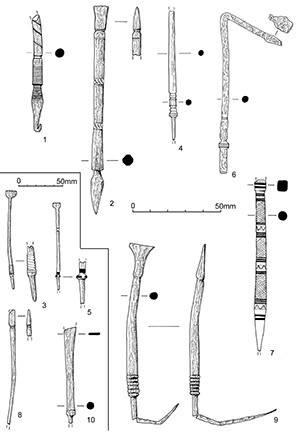
1. Handle, point bent back on itself, and the end of the handle and eraser missing. The handle is moulded, with incised and inlaid brass wire decoration. The eraser end has an incised spiral line, with a single band of brass wire below. Below this is a band of fine ribbing. The bulbous point has an inlaid spiral of brass wire. L. 65mm. SF664, Fill 4009, Pit 4008, Group 756, Area K, Period 3
2. Complete, surface in poor condition. The point is bulbous, and the eraser narrow, with only a slight flare. There are traces of moulding on the stem, with two shallow grooves on the neck between the eraser and the handle, and two more about 3mm further up. In addition, there are two bands with oblique, shallowly impressed lines. The section of the stem at the point end was facetted, probably with a pentagonal section but the surface is in such poor condition that it is impossible to say whether the entire handle had the same section. L. 117mm. Cleaning layer 5662, Area I, not phased
This group has semi-circular erasers. The stem tends to swell slightly towards the point, but this is not invariable, and the decoration principally comprises grooves and inlaid bands. There are examples from Aldborough (Bishop 1996, 34, no. 198), Verulamium (Stead and Rigby 1989, 32, nos 188-9), Scole (Rogerson 1977, 142, nos 7-8) and Silchester (Boon 1974, 227, fig. 34, no. 11). Five are from dated contexts, suggesting a 3rd to 4th-century date for the type.
3. Almost complete, point missing, and with a semi-circular eraser. The bottom of the handle has a band of brass round a reel, with oblique impressed lines apparently formed after the brass was inlaid; above this there is a spiral groove. XRF analysis showed the inlay to be brass. L. 111mm. SF4141, Fill 4692, Slot 4695, Group 1161, Area K, not phased
The members of this group, while somewhat similar to group 4, have wedged erasers and a bead between the handle and point. The other two examples are both from Aldborough (Bishop 1996, 34, nos 195 and 197), and undated. The two Elms Farm examples are both from dated contexts, one Early Roman and one latest Roman. Assuming that this form of stylus was not produced throughout the Roman period, the stylus from 21570 can be taken to be residual, giving an Early Roman date for the type.
4. The point and eraser are missing. There are four reels above the point, all inlaid with copper-alloy strips. The reel nearest the point is corrugated, and the third reel has eleven facets. L. 73mm. Fill 4049, Pit 4048, Group 756, Area K, Period 3
5. In two non-joining pieces, probably nearly complete. The eraser is short and rectangular. There is a bead-like moulding immediately above the point, with an inlaid copper-alloy band round it, and a second copper-alloy band above the bead. L. >98mm. Fill 21570, Robber trench 21815, Group 447, Area J, Period 6
6. The point is missing, and the stem bent. It has a reel above the point with an applied corrugated copper-alloy strip. Above this is a smaller reel, with an inlaid, plain strip of copper alloy further up the handle. The original shape of the eraser is uncertain. The undecorated reel has a very slight groove round the middle, which was probably the seating for another copper-alloy band, now lost. XRF analysis showed that both bands were brass (Cu/Zn). L. (straight) 129mm. SF8232, Fill 15756, Pit 15755, Group 712, Area M, Period 5
This group has a swelling at the junction between the handle and point, more pronounced on some examples than others, with an undifferentiated point. It includes the most elaborately decorated stylus from Elms Farm, which has its handle entirely covered in decorative elements, and which must have been extremely fiddly to make. There are nine examples, with deposition dates ranging from the 2nd to the 4th century.
The decoration of the Elms Farm stylus has affinities with the copper-alloy stylus from London, mentioned under Group 1, although the point is quite different. Both have bands with triangular facets, and cross-hatching, though in the case of the London stylus it is moulded or incised rather than applied. The use of an applied lattice is almost unparalleled, but appears in silver on an undated Group 5 stylus from Brancaster (Sparey Green and Hinchliffe 1985, 53, no. 77), together with bands of brass.
7. Point and eraser missing. It is very finely decorated with inlaid bands and lattice decoration in brass, along the whole length of the handle. The handle has a variable circular section, with a square-sectioned collar below the eraser. The iron is in fairly poor condition, and has cracked through near the eraser end. The decoration is as follows (from the point); 2 medium bands - broad band - 2 narrow bands - lattice - 2 narrow bands - broad band - 3 narrow bands - lattice - 4 narrow bands - broad band - 2 narrow bands - lattice - 2 narrow bands - 2 narrow bands - square-sectioned collar with 2 medium bands. Each broad band is applied to a faceted segment of iron, with triangular facets alternately pointing up and down. There are probably ten facets on each band, but the stylus was only partly cleaned, and the full section is not visible. The lattice is made from individual strips of brass. VF notes that there was some loss of decoration during cleaning. XRF analysis of the inlay showed it to be brass, with a trace of tin. L. 97mm. SF1253, Fill 6001, Pit 6006, Group 553, Area H, Period 4
The group has straight-sided erasers and simple decoration. The handles are slender, with undifferentiated points. The Elms Farm stylus probably belongs to this group, but little of the eraser survives. The nine examples identified range in date from 2nd to 4th century.
8. Point missing. The base of the narrow, elongated eraser is constricted, with two moulded rings. In two pieces. L. 130mm. Cleaning layer 20000, Area L, not phased
9. The point is unusually long, although cracked and bent during excavation. The bottom of the handle has six circumferential grooves, and the well-formed flared eraser has a slight step at the junction with the handle. L. (straight) 141mm. SF4149, Fill 4825, Pit 14098, Group 4019, Area K, Period 4-5
10. Incomplete stylus, with a relatively thick handle with a circular section, becoming squarer towards the elongated, flared eraser, the end of which is missing. Above the broken point there is a low moulding flanked by a groove. The moulding may have been formed by wrapping a small strip of iron round the stem. Cf Manning N28 and N29. The former was found in the Thames in association with 1st-century coins. L. 109mm, max. surviving W. of eraser 14mm. SF4374, Cleaning layer 5662, Area I, not phased
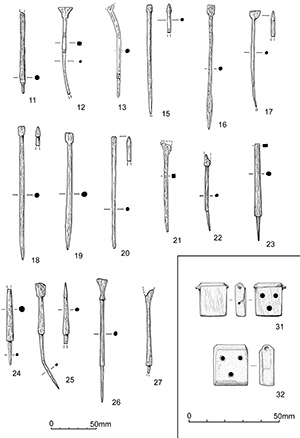
11. Eraser missing. The bottom of the handle has an inlaid band of copper alloy, 2mm wide, and the point is separated from the handle. L. 89mm, Diam. 5mm. Fill 10891, Pit 10910, Group 676, Area N, Period 5
12. The shaft has two bands of shallow grooves, with a slightly shouldered, flared eraser. The point is missing, and it is slightly bent. L. 97mm. SF6214, Cleaning layer 14516, Area L, not phased
13. Stylus with a simple moulding towards the point end. Most of the eraser and point missing. Bent. L. 100mm. SF7487, Spread 20186, Group 8005, Area L, not phased
14. Not illustrated. Manning type 1. Made from a rod of almost constant diameter, tapering sharply at one end, and with the other end flattened into an eraser, now incomplete. The eraser was probably not shouldered. L. 134mm, Diam. 4mm. SF251, Machining layer 4000, Area A, unstratified
15. Stylus of simple form, with a narrow wedge eraser, and a tapering circular sectioned handle. The point is missing. Manning type 1. L. 128mm. SF337, Fill 4015, Pit 4102, Group 739, Area K, Period 4
16. Manning Type 1, with a wedge eraser. The stem is slightly bulbous above the undifferentiated point. L. 138mm. SF5096, Cleaning layer 5607, Area I, not phased
17. Manning type 1. The point is missing, and the eraser is D-shaped. In poor condition. L. 105mm, W. of eraser 12mm. Fill 10000, Pit 10062, Group 811, Area E, Period 4
18. Manning type 1, with a wedge-shaped eraser. L. 148mm. SF6444, Layer 10978, Group 8007, Area N, not phased
19. Manning type 1. Plain, with an undifferentiated point and a small wedge-shaped eraser. L. 133mm. SF6164, Machining layer 12000, Area R, not phased
20. A simple stylus with an undifferentiated point and a narrow eraser. The section is circular throughout. In two pieces, with an ancient break. L. 123mm. Cleaning layer 14609, Area L, not phased
21. Manning type 1a? This is not definitely a stylus, and could possibly be a chisel. The point is missing, and the section is square rather than round, as is more normal. The form of the eraser is simple, and could be a chisel blade. However, the almost complete lack of taper in the handle, and the size (the tang would be unusually long for a simple chisel) tend to suggest that this is a stylus. L. 100mm. SF345, Machining layer 5000, Area J, not phased
22. Manning type 2. A small example with an incomplete rectangular eraser, only slightly wedged. There is a slight step between the handle and the point (side view not illustrated as no X-ray available). L. 78mm. SF314, Machining layer 5000, Area J
23. Manning type 2. The eraser is missing. L. 116mm. SF2311, Layer 5441, Group 455, Area J, Period 6
24. Stylus, with the eraser end missing. Manning type 2/3. The handle has a tapering circular section, with a sharply defined shoulder above the square-sectioned point. L. 84mm. Fill 14377, Pit 14376, Group 264, Area L, Period 2B
25. Manning type 3, distorted. The point is unusually long compared to the handle. L. 123mm. SF1150, Fill 4239, Pit 4128, Group 744, Area K, Period 6
26. Manning type 3, with both point and splayed eraser clearly separated from the stem. L. 134mm.SF316, Machining layer 5000, Area J, not phased
27. Manning type 3, somewhat distorted. The point is missing, and the eraser damaged. The eraser is thin and splayed, and is without shoulders. (The illustration is a reconstruction of its original shape) L. 97mm. SF5785, Cleaning layer 10905, Area N, not phased
28. Not illustrated. Stylus, shaft broken. The shouldered eraser is incomplete. L. 60mm. SF427, Fill 4212, Pit 4211, Group 756, Area K, Period 3
29. Not illustrated. Stylus eraser, the shaft broken in antiquity. The eraser is a narrow rectangle, wedged and shouldered. L. 56mm, eraser 14x5mm. Fill 5144, Pit 5145, Group 430, Area J, Period 4
30. Not illustrated. Probable stylus eraser, with part of the shaft, which has sustained recent damage. The shaft probably has a circular section. The eraser is a simple flared shape, with no shoulders. L. 63mm, eraser L. 20mm, max. W. 9mm. Fill 5161, Pit 5178, Group 437, Area J, Period 5
There were two almost identical copper-alloy seal boxes from the site, both plain and rectangular. Plain rectangular seal boxes are continental, and pre-conquest, which accounts for their rarity in British contexts. Early seal boxes have been found in Gaul (Feugère 1998), and other parts of the western Europe, but the writer knows of no others of this type from Britain. Unfortunately, both the boxes were from the topsoil, so it is impossible to say whether they arrived at the site before or after the conquest. There is other imported pre-conquest metalwork from Elms Farm, so it is possible that the seal boxes were from the same source.
There is a parallel from Neuss (Simpson 2000, pl. 21.14), similar in size to the Heybridge examples, but also from an undated context.
31. Rectangular seal box, complete, with a plain top and three holes in the back. The hinge may have an iron axis bar, in very good condition, probably with the remains of a copper-alloy washer or cap at one end. The top and bottom surfaces have slanting file marks; Margaret Brooks suggests that they may have been deliberately made to enhance the shine. 18x14x5mm. SF2995, Machining layer 11000, Area A, unstratified

32. Rectangular seal box, complete but in fairly poor condition, with some damage to the unstable surface. The top is plain bar a line round at least part of the edge, and there are three holes in the base. One side has a slot for the string, while the other is half missing, evidently broken in antiquity. The hinge pin is possibly iron. L. 23mm, W. 19mm, Th. 8mm. SF6824, Machining layer 12346, Area B, unstratified
Internet Archaeology is an open access journal based in the Department of Archaeology, University of York. Except where otherwise noted, content from this work may be used under the terms of the Creative Commons Attribution 3.0 (CC BY) Unported licence, which permits unrestricted use, distribution, and reproduction in any medium, provided that attribution to the author(s), the title of the work, the Internet Archaeology journal and the relevant URL/DOI are given.
Terms and Conditions | Legal Statements | Privacy Policy | Cookies Policy | Citing Internet Archaeology
Internet Archaeology content is preserved for the long term with the Archaeology Data Service. Help sustain and support open access publication by donating to our Open Access Archaeology Fund.